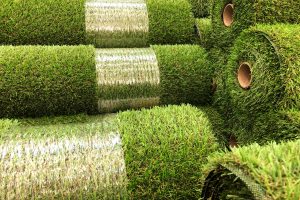Broadleaf Carpetgrass – Is It the Right Grass for You?
This perennial warm-season grass is an appealing choice for homeowners in tropical parts of Australia – especially northern Queensland. With excellent shade but poor drought ...

 It is impossible to deny that a natural green lawn looks, feels and is good.
It is impossible to deny that a natural green lawn looks, feels and is good.
But, in today’s fast-paced society, artificial turf can be considered the easy, low maintenance alternative, ultimately saving water, time and money.
Even with advances in technology and improved materials, artificial turf might look like an attractive option, but it is more expensive to our environment, your health, your hip pocket and your property value.
Artificial turf is often chosen because homeowners feel it is easy to maintain, requires no watering and retains a year-round green colour.
Despite these features, research has found that artificial turf is environmentally unfriendly, can cause burns and scars to those playing on it and during summer can be up to 30°C hotter than natural turf. This means on the days when you would most likely want enjoy your backyard – it may be too hot!

Artificial turf is made up of polypropylene and polyethylene.
Polypropylene is a hard-wearing plastic polymer and is found in many plastic items such as dishwasher-safe food containers.
Polyethylene is synthesised from ethylene, a compound that’s usually made from petroleum or natural gas.
To provide shock absorbency, artificial turf is usually installed with a layer of polypropylene or rubber granules (typically made from recycled car tyres) and sand as an “infill”.
As artificial turf degrades with use and age, its components break down into smaller pieces.
These tiny microfibers can be easily inhaled, especially when a someone falls and/or slides across the artificial turf surface.
In addition, recycled rubber contains many heavy metals such as cadmium, chromium, lead, molybdenum, selenium and sulphur that have been absorbed into the rubber while in use as a vehicle tyre.
 Natural turf is completely organic, “powered” by sunlight, nutrients and water, is naturally safe and is recognised for having important aesthetic, health and environmental benefits.
Natural turf is completely organic, “powered” by sunlight, nutrients and water, is naturally safe and is recognised for having important aesthetic, health and environmental benefits.
Natural turf has been found to absorb more noise and reflects less light, reducing glare, compared to artificial turf.
You might think that natural turf needs a lot of water to become established and remain healthy compared to artificial turf?
However, natural turf varieties are available that don’t need a lot of water to keep them in tiptop shape, for example, Soft Leaf Buffalo or Zoysias.
 Has a cooling effect. The temperature on a green lawn in midsummer can be 10 Degrees Centigrade less than bare soil, 20 Degrees Centigrade less than asphalt, concrete or pebbles and almost 40 Degrees Centigrade less than artificial turf!
Has a cooling effect. The temperature on a green lawn in midsummer can be 10 Degrees Centigrade less than bare soil, 20 Degrees Centigrade less than asphalt, concrete or pebbles and almost 40 Degrees Centigrade less than artificial turf!
Is environmentally friendly. Turf improves water quality by filtering runoff and reducing erosion. Turf also reduces greenhouse gases by absorbing carbon dioxide and producing oxygen.
Promotes wellbeing. Open natural greenspace promotes physical exercise and improves mental health.
Uses less water than you think. There are five main turf types and many different varieties to choose from – drought tolerant and water efficient options are available. Turf also grows well using recycled water and water saving crystals.
Is a natural product. Turf self-replenishes, provides a natural fire barrier, reduces noise and can increase home values by up to 18 per cent!
 The turf installation cost for natural turf differs to artificial turf.
The turf installation cost for natural turf differs to artificial turf.
Artificial turf can cost up to three times as much to purchase and install as natural turf.
Installing synthetic grass may be as much as $90 per square metre compared with as little as $20/m2 for site preparation, buying and laying of natural turf.
Natural turf does need to be maintained though through mowing, watering, and fertilising.
While the above costs don’t exist with artificial turf, it still requires several maintenance procedures, such as:
 In addition, some artificial turf manufacturers recommend, that during summer, apply water to offset the high temperatures.
In addition, some artificial turf manufacturers recommend, that during summer, apply water to offset the high temperatures.
Finally, natural turf lasts a lifetime whereas artificial turf needs to be replaced at least every 10-12 years
.
Sign up for our Newsletter to receive your free guide.
